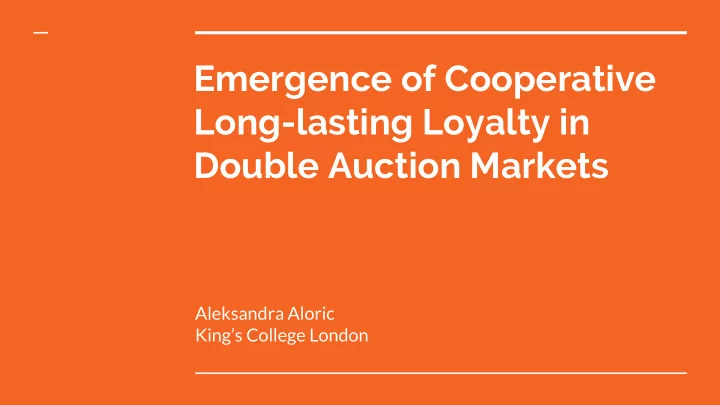

Emergence of Cooperative Long-lasting Loyalty in Double Auction Markets Aleksandra Aloric King’s College London
Motivation Always buy from the same merchants? ● Loyalty by design ○
Motivation Always buy from the same merchants? ● Loyalty by design ○ CAT tournaments indicate loyalty can arise as ● consequence of coadaptation
Motivation Always buy from the same merchants? ● Loyalty by design ○ CAT tournaments indicate loyalty can arise as ● consequence of coadaptation AIM Design stylized model of agents choosing among multiple ● markets to investigate whether loyalty can emerge spontaneously
2 Double Auction markets Discrete time ● Globally set trading price ● Model Agents Aloric et al. (2015) Advances in Artificial Choosing Strategy ● Economics Trading Strategy ● Aloric et al. (2016) PloS ONE
Markets Executes trades based on which traders evaluate returns ● Sets a global trading price based on submitted bids and ● asks π = π eq + θ (<b> − <a>) ● Matches buyers to sellers ● No limit order book ●
Markets - price setting π = π eq + θ (<b> − <a>)
Markets - returns S Sm (n) = π m (n) - a(n) S Bm (n) = b(n) - π m (n)
Agents - Choosing strategy Where to trade? (which market) ● How to trade? (to buy or to sell) ●
Agents - Choosing strategy Where to trade? (which market) ● How to trade? (to buy or to sell) ● Decision is based on attractions : ●
Agents - Trading strategy Zero Intelligence Traders Bids/Asks are iid Gaussian random variables ● No dependence on previous success ● No information about other traders ● No wealth constraint ● Want to trade 1 unit of stock per trading period ●
Numerical Results � =3.45
Numerical Results � =7.15
Agents’ preference for Buying ● Analytical (Selling) non adaptive - determined on input Model Only choice is where to trade ● Still develop loyalty in ● Agents with fixed Buy-Sell simulations, but easier to preferences analyse
Benefits of Segregation
Phase Diagram
Phase Diagram
Robustness Assumptions on Bid/Ask distributions ● Reinforcement learning ● Wealth constraints ● More sophisticated trading strategies ● Continuous Double Auction Market ●
Summary Simple numerical model of double auction markets ● Observed long lasting loyalty for certain range of ● parameters Above critical intensity of choice � : the system is ● stabilized by traders who persistently chose to trade at suboptimal market - cooperative trade-enabling action Even the volume driven agents benefit from segregated ● state Adaptation/Learning is the key driver of segregation ●
Thank you for the attention! aleksandra.aloric@gmail.com
Recommend
More recommend